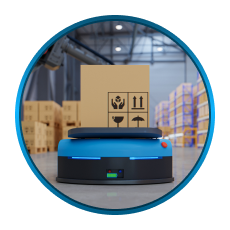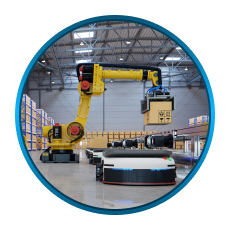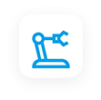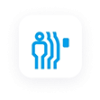Automation is reshaping industries at unprecedented rates. But while robots, AGVs, and heavy machinery become increasingly vital to manufacturing, workplace safety is as crucial as maintaining manufacturing efficiency. A safety laser and obstacle detection scanner offers the best compromise, functioning as both a safety safeguard device and an intelligent obstacle detection system.
When compared to static light curtains or fixed guards, two-way scanners are always on the lookout, adapt to evolving workflows, and prevent accidents without slowing processes down. Across fleets of factory floors, warehouses, and transportation, scanners provide more intelligent protection while also increasing productivity.
In this article, we'll explore how dual-purpose scanners work, why industries are choosing them over older systems, and how they're powering safer, more productive automation.
Why Safety Laser and Obstacle Detection Scanners Are Essential

Automation is no longer optional - it's a competitive necessity. From transportation, equipment manufacturing to robotics engineering, machines are handling tasks once reserved for people. This shift improves speed and accuracy but also introduces new risks when humans and machines share space.
Common Challenges in Worker and Machine Safety
Accidents often happen when safety systems fail to adapt. Blind spots, human error, and outdated guarding methods can lead to collisions, downtime, or injuries. With OSHA reporting thousands of machine-related accidents annually, proactive safety has become mission-critical.
Where Traditional Safety Devices Fall Short
Fixed guards, light curtains, and pressure mats provide basic protection but lack adaptability. They either obstruct workflow, require frequent calibration, or can't handle complex environments where people and robots interact dynamically.
How Dual-Purpose Scanners Work

Safety laser and obstacle detection sensors use LiDAR (Light Detection and Ranging) to emit laser pulses, measure reflection times, and map environments in real time.
Protective vs. Warning Zones
One of their key advantages is programmable multi-zone monitoring:
- Protective zones immediately stop a machine when breached.
- Warning zones signal a slowdown when an object approaches.
This layered safety model ensures both proactive and reactive protection.
Real-Time Hazard Detection and Prevention
With scanning speeds of up to 40Hz and wide fields of view (often 270°), dual-purpose scanners identify risks instantly. This allows AMRs, conveyors, or robotic arms to adjust behavior in milliseconds - avoiding accidents before they occur.
Benefits of Dual-Purpose Safety and Obstacle Detection Scanners
Enhanced Worker Safety
By actively monitoring for human presence, scanners reduce accidents from accidental contact, blind spots, or overlooked hazards.
Boosting Productivity Without Sacrificing Security
Unlike rigid safety systems that force constant machine stoppages, scanners allow dynamic control- machines only pause when truly necessary, keeping operations efficient.
Supporting Smarter Human-Robot Collaboration
Collaborative robots (cobots) and AGVs can work alongside humans safely, thanks to intelligent detection zones that adapt as people move around them.
Applications Across Industries
- Manufacturing and Industrial Machinery
Protect operators working near presses, CNC machines, or conveyors while maintaining uptime. - Robotics and AGVs/AMRs
Enable safe navigation and collision avoidance in warehouses, distribution centers, and assembly plants. - Civil Engineering and Construction
Provide safety monitoring around cranes, mobile machinery, and complex site layouts. - Aerospace and Transportation Equipment
Ensure precision handling and safety in environments where high-value components and human workers interact.
Comparing Safety Laser Scanners and Traditional Solutions
| Feature | Light Curtains | Safety Laser Scanners |
|---|---|---|
| Coverage | Narrow, linear | Wide 270° area |
| Flexibility | Fixed zones only | Programmable zones |
| Productivity Impact | Frequent downtime | Minimal interruptions |
| Blind Spot Detection | Limited | Comprehensive |
| Human Error Mitigation | Low | High |
Safety laser and obstacle detection sensors provide adaptive, flexible protection - whereas light curtains and fixed barriers often slow production.
Future of Dual-Purpose Scanners
Integration with AI for Predictive Safety
Pairing scanners with AI will enable predictive hazard detection, anticipating risks before they occur.
Smarter Fleet and Facility Coordination
In large facilities, fleets of AGVs equipped with scanners will communicate with each other, creating organized, collision-free “traffic systems.”
As manufacturers trend toward higher levels of automation, flexible and reliable safety is demanded. Traditional guarding systems can't keep up with the fast, dynamic conditions prevalent today. That's why laser and obstacle detection scanners are used as a standard, providing real-time tracking, adaptive safety zones, and smooth integration with automated systems.
With these multi-purpose sensor solutions, manufacturers and operators can protect people, reduce downtime, and increase efficiency without losing productivity or speed.
At Hokuyo, we design precision-engineered sensors that facilitate more intelligent, more secure automation.
Learn how our scanners can help you create safer buildings and wiser fleets.

 Factory Automation
Factory Automation Logistics Automation
Logistics Automation Process Automation
Process Automation Crane Collision Avoidance
Crane Collision Avoidance LiDAR/Obstacle Detection
LiDAR/Obstacle Detection Safety Laser Scanners
Safety Laser Scanners Optical Data Transmission
Optical Data Transmission Hot Metal Detectors
Hot Metal Detectors Laser Distance Sensor
Laser Distance Sensor Blog
Blog Whitepapers
Whitepapers Case Studies
Case Studies Infographics
Infographics